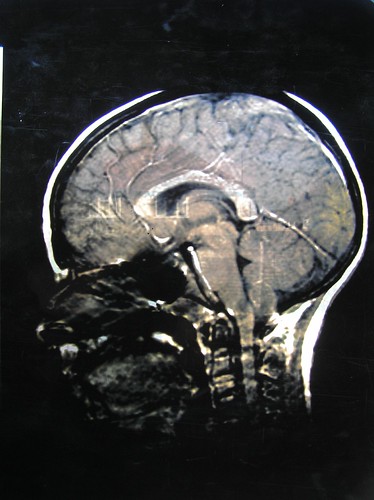To the tune of: Green Day – Brain Stew
My preamble: One of the few blessings of attending Oxford, save for the acquisition of an archaic process of thought, was my acquaintance with my admirable friend Dr Paul Taylor. Paul is, apart from being an awesome trumpeter, a professor of Neuroscience, with a speciality in attention and… uh, I wasn’t listening to the rest. Something about decision-making and consciousness. Anyway, this is the future, the human brain, the great unknown canyons of the mind; focus!
Paul’s preamble: As part of my reply I have been doing such things as starting to read Neuromancer and then forgetting about it for a bit. My widdlings follow —

You stimulate reactions in your patients with with what is basically a big magnet. Is this procedure something that could eventually be automated – that is, before any interface is installed, a short automated configuration period would be needed to identify the relevant brain centres?
—what we sometimes do at the moment is first scan people to see which areas ‘light up’ in response to a task, and then use some clever registration software involving an infrared camera and some tracking pointers so that we can find the part on their skull directly above that activation ‘blob’ – and then zap it. So it could be in a different place for different people but we’d find it.
How fine is our current level of interaction with these areas? What technical innovations would be needed to improve this?
—in one sense not fine at all and in another quite impressive. These stimulators I use are pretty bulky and definitely activate millions of brain cells immediately after this pulse. On the other hand some of the effects can be very sensitive – often we’re able for example to specifically produce a twitch in someone’s right index finger, for example, rather than the other fingers. To improve it we need some means of producing extremely focal magnetic pulses which are strongest at some distance from the stimulating device – it’s still a centimetre or even two from the top of your head down through the skull to the first bit of brain. Or, tiny little nanobots that can somehow cross the blood-brain barrier and be remotely triggered and moved around.
People have been known to kill themselves over things as innocuous as tinnitus – are there any dangers from direct brain stimulation?
–funny you mention tinnitus, it’s one of the few things which transcranial magnetic stimulation has been suggested to be used to treat. Tinnitus – a hallucinatory auditory experience – can be caused by all sorts of different things from the ear to the brain. Some types, maybe, you can make go away entirely by zapping the right bit.
Important to mention here is that the clinical doses are way beyond the experimental doses I use. For example, I use a MAXIMUM of 1500 quite weak pulses in a day. These clinical doses use ten to a hundred times that, every day for months.
The brain is highly adaptable. Does this adaptability vary with age? Brains can rewire themselves to bypass paralysis, etc – is this something we could induce to allow connection with unfamiliar connections? E.g. implanting an coprocessor at an early age which allows a defined level of control over a drone unit, and allowing the brain time to work out how to use this as an extra limb, say?
–OK lots of things here. Brains are as you say highly adaptable – almost to the point of being the best definition of what a brain is – adaptable. The rewiring after paralysis (‘plasticity’) is currently studied a lot, including with TMS. For example, I mentioned above the thing where you can stimulate the motor cortex to produce a motor twitch. You can also do other things, like slow someone at doing something complicatedly fiddly, such as wiring a plug. If you stimulate their ‘premotor’ cortex – another part of brain – normally people get worse at using the hand represented by that side of the brain. If someone has a stroke such that one side of the brain is damaged then sometimes the other side of the brain starts to take over. You can show that stimulating that other side of the brain starts to have the effects which the old side used to. So now they only get worse if you stimulate the other side.
—you could have a prosthesis implanted so you could control an arm. The wiring would be a bit fiddly though. The best way to go about it though is to make the most of the brain’s adaptability. Rather than trying to plug something in the right way to just replace or extend something like a hand, say, instead just splash something in the cortex and let people figure it out. People are very good this. Did you hear the recent experiment at Duke university with the monkey operating a joystick in new york with it’s motor cortex?
—I was at a conference recently where they were showing video footage of people who’d had both hands amputated after an accident. They then transplanted new hands onto the old hands. People could use them – one patient could very easily strip the wire off a plug and – amazingly – also waved his hands around automatically as he talked. They, again, stimulated the motor cortex to demonstrate how the brain had reorganised.

Fiction writers always imagine technology to be invasive; are there any benefits from implanted brain tech? What disadvantages are there to implants?
–I guess the problem would be that presumably the implant would have a single fixed function. The brain is always changing though – from milliisecond to millisecond and from year to year. So one problem would be having an implant that could change with the brain.
–The other problem is – well, it’s like this. To be honest, neuroscientists as a whole don’t really have the flying first idea what most parts of the brain are really doing. Neuroscientists individually do, but there’s no real agreement on anything. So everyone would have a different idea of which bit should be plugged in where.
The brain seems to be able to transfer routine actions to a non-conscious brain element eventually; is there anything barring integrated technologies from being subconscious as well?
– absolutely nothing barring that, one would expect that to happen as a matter of course.
This is all stream of consciousness on my part – what have I missed out?
–there’s so much to be said here, i don’t know where to begin. There’s a big research initiative here in Munich on robotics, i’ll look out for new findings that might be of interest.
Thank you, Paul!
Leave a comment